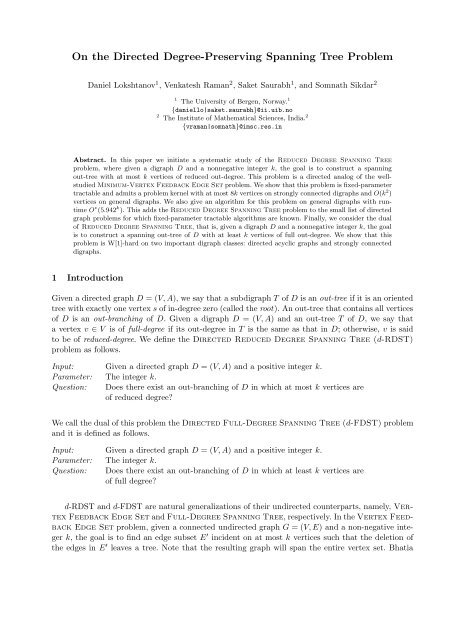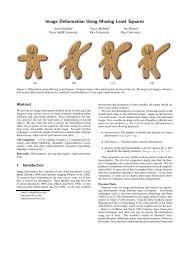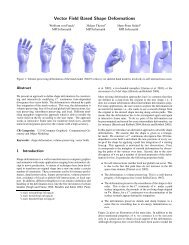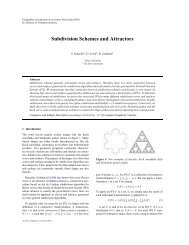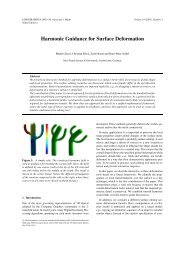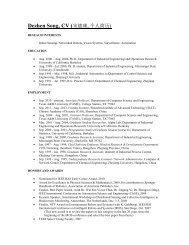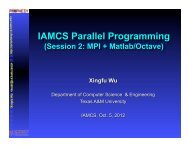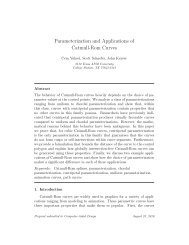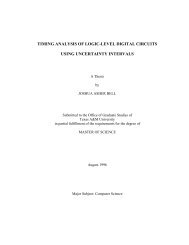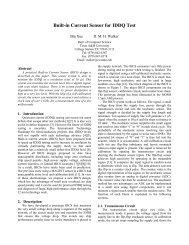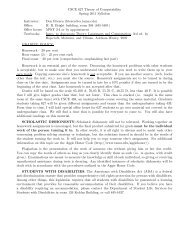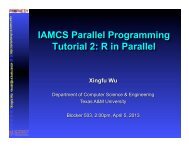On the Directed Degree-Preserving Spanning Tree Problem
On the Directed Degree-Preserving Spanning Tree Problem
On the Directed Degree-Preserving Spanning Tree Problem
You also want an ePaper? Increase the reach of your titles
YUMPU automatically turns print PDFs into web optimized ePapers that Google loves.
<strong>On</strong> <strong>the</strong> <strong>Directed</strong> <strong>Degree</strong>-<strong>Preserving</strong> <strong>Spanning</strong> <strong>Tree</strong> <strong>Problem</strong><br />
Daniel Lokshtanov 1 , Venkatesh Raman 2 , Saket Saurabh 1 , and Somnath Sikdar 2<br />
1 The University of Bergen, Norway. 1<br />
{daniello|saket.saurabh}@ii.uib.no<br />
2 The Institute of Ma<strong>the</strong>matical Sciences, India. 2<br />
{vraman|somnath}@imsc.res.in<br />
Abstract. In this paper we initiate a systematic study of <strong>the</strong> Reduced <strong>Degree</strong> <strong>Spanning</strong> <strong>Tree</strong><br />
problem, where given a digraph D and a nonnegative integer k, <strong>the</strong> goal is to construct a spanning<br />
out-tree with at most k vertices of reduced out-degree. This problem is a directed analog of <strong>the</strong> wellstudied<br />
Minimum-Vertex Feedback Edge Set problem. We show that this problem is fixed-parameter<br />
tractable and admits a problem kernel with at most 8k vertices on strongly connected digraphs and O(k 2 )<br />
vertices on general digraphs. We also give an algorithm for this problem on general digraphs with runtime<br />
O ∗ (5.942 k ). This adds <strong>the</strong> Reduced <strong>Degree</strong> <strong>Spanning</strong> <strong>Tree</strong> problem to <strong>the</strong> small list of directed<br />
graph problems for which fixed-parameter tractable algorithms are known. Finally, we consider <strong>the</strong> dual<br />
of Reduced <strong>Degree</strong> <strong>Spanning</strong> <strong>Tree</strong>, that is, given a digraph D and a nonnegative integer k, <strong>the</strong> goal<br />
is to construct a spanning out-tree of D with at least k vertices of full out-degree. We show that this<br />
problem is W[1]-hard on two important digraph classes: directed acyclic graphs and strongly connected<br />
digraphs.<br />
1 Introduction<br />
Given a directed graph D = (V,A), we say that a subdigraph T of D is an out-tree if it is an oriented<br />
tree with exactly one vertex s of in-degree zero (called <strong>the</strong> root). An out-tree that contains all vertices<br />
of D is an out-branching of D. Given a digraph D = (V,A) and an out-tree T of D, we say that<br />
a vertex v ∈ V is of full-degree if its out-degree in T is <strong>the</strong> same as that in D; o<strong>the</strong>rwise, v is said<br />
to be of reduced-degree. We define <strong>the</strong> <strong>Directed</strong> Reduced <strong>Degree</strong> <strong>Spanning</strong> <strong>Tree</strong> (d-RDST)<br />
problem as follows.<br />
Input: Given a directed graph D = (V,A) and a positive integer k.<br />
Parameter: The integer k.<br />
Question: Does <strong>the</strong>re exist an out-branching of D in which at most k vertices are<br />
of reduced degree?<br />
We call <strong>the</strong> dual of this problem <strong>the</strong> <strong>Directed</strong> Full-<strong>Degree</strong> <strong>Spanning</strong> <strong>Tree</strong> (d-FDST) problem<br />
and it is defined as follows.<br />
Input: Given a directed graph D = (V,A) and a positive integer k.<br />
Parameter: The integer k.<br />
Question: Does <strong>the</strong>re exist an out-branching of D in which at least k vertices are<br />
of full degree?<br />
d-RDST and d-FDST are natural generalizations of <strong>the</strong>ir undirected counterparts, namely, Vertex<br />
Feedback Edge Set and Full-<strong>Degree</strong> <strong>Spanning</strong> <strong>Tree</strong>, respectively. In <strong>the</strong> Vertex Feedback<br />
Edge Set problem, given a connected undirected graph G = (V,E) and a non-negative integer<br />
k, <strong>the</strong> goal is to find an edge subset E ′ incident on at most k vertices such that <strong>the</strong> deletion of<br />
<strong>the</strong> edges in E ′ leaves a tree. Note that <strong>the</strong> resulting graph will span <strong>the</strong> entire vertex set. Bhatia
et al. [4] show that this problem is MAX SNP-hard and describe a (2 + ǫ)-approximation algorithm<br />
for it for any fixed ǫ > 0. Guo et al. [14] show that this problem is fixed-parameter tractable by<br />
demonstrating a problem kernel with at most 4k vertices.<br />
The Full-<strong>Degree</strong> <strong>Spanning</strong> <strong>Tree</strong> problem asks, given a connected undirected graph G =<br />
(V,E) and a non-negative integer k as inputs, whe<strong>the</strong>r G has a spanning tree T in which at least k<br />
vertices have <strong>the</strong> same degree in T as in G. This problem has attracted a lot of attention of late [5, 6,<br />
4, 14, 13]. Bhatia et al. [5] studied this problem from <strong>the</strong> point-of-view of approximation algorithms<br />
and gave a factor-Θ( √ |V |) algorithm for it. They also showed that this problem admits no factor<br />
O(|V | 1/2−ǫ ) approximation algorithm unless NP = co-R. For planar graphs, a polynomial-time<br />
approximation scheme (PTAS) was presented. Independently, Broersma et al. [6] developed a PTAS<br />
for planar graphs and showed that this problem can be solved in polynomial time in special classes<br />
of graphs such as bounded treewidth graphs and co-comparability graphs. Guo et al. [14] studied <strong>the</strong><br />
parameterized complexity of this problem and showed it to be W[1]-hard. Gaspers et al. [13] give<br />
an O ∗ (1.9465 |V | ) algorithm for this problem.<br />
These problems on undirected graphs were first studied by Pothof and Schut [17] in <strong>the</strong> context<br />
of water distribution networks where <strong>the</strong> goal is to determine <strong>the</strong> flow in a network by installing a<br />
small number of flow-meters. It so happens that to measure <strong>the</strong> flow in each pipe of <strong>the</strong> network,<br />
it is sufficient to find a spanning tree of <strong>the</strong> network and install flow-meters at those vertices whose<br />
degree in <strong>the</strong> spanning tree is lesser than that in <strong>the</strong> network. To find an optimal number of flowmeters<br />
(which are expensive equipment) one needs to find a spanning tree with <strong>the</strong> largest number of<br />
vertices of full degree. Since networks are best modeled by directed graphs, it is natural to consider<br />
<strong>the</strong> directed analog of <strong>the</strong> notion of a degree-preserving spanning tree.<br />
Related Results on Constrained <strong>Spanning</strong> <strong>Tree</strong> <strong>Problem</strong>s. The Full <strong>Degree</strong> <strong>Spanning</strong> <strong>Tree</strong> problem<br />
is one of <strong>the</strong> many variants of <strong>the</strong> generic Constrained <strong>Spanning</strong> <strong>Tree</strong> problem, where one<br />
is required to find a spanning tree of a given (di)graph subject to certain constraints. This class of<br />
problems has been studied intensely of late [1, 7, 8,10, 11, 15, 18].<br />
In [10], <strong>the</strong> authors consider <strong>the</strong> problem Max Leaf <strong>Spanning</strong> <strong>Tree</strong> where one is required to<br />
find a spanning tree of an undirected graph with <strong>the</strong> maximum number of leaves. When parameterized<br />
by <strong>the</strong> solution size, this problem admits a kernel with 3.75k vertices. In <strong>the</strong> directed variant of this<br />
problem, one has to decide whe<strong>the</strong>r an input digraph D has an out-branching with at least k leaves.<br />
This problem admits a kernel with O(k 3 ) vertices, provided <strong>the</strong> root of <strong>the</strong> out-branching is given<br />
as part of <strong>the</strong> input [11], and has an algorithm with run-time O(3.72 k · |V (D)| O(1) ) [8]. Ano<strong>the</strong>r such<br />
problem is Max Internal <strong>Spanning</strong> <strong>Tree</strong>, where <strong>the</strong> objective is to find a spanning tree (or an<br />
out-branching, in case of digraphs) with at least k internal vertices. For <strong>the</strong> undirected graphs case,<br />
an O(k 2 )-vertex kernel is known for this problem [18]. In <strong>the</strong> case of directed graphs, an O(k 2 )-vertex<br />
kernel due to [15] and an algorithm with run-time O ∗ (40 k ) due to [7] is known for this problem.<br />
Our Contribution. We study <strong>the</strong> directed analogues of <strong>the</strong> <strong>Degree</strong>-<strong>Preserving</strong> <strong>Spanning</strong> <strong>Tree</strong><br />
problem from <strong>the</strong> point of view of parameterized complexity. We show that d-RDST is fixed-parameter<br />
tractable (FPT) by exhibiting a problem kernel with at most O(k 2 ) vertices. For strongly connected<br />
digraphs, d-RDST admits a kernel with at most 8k vertices. We describe a branching algorithm for<br />
<strong>the</strong> d-RDST problem with run time O ∗ (5.942 k ). Our fixed parameter tractable and kernelization<br />
algorithms are sufficiently non-trivial and exploit structures provided by <strong>the</strong> problem in an elegant<br />
way. Finally, we show that d-FDST is W[1]-hard, by a reduction from <strong>the</strong> Independent Set problem,<br />
on two classes of digraphs: directed acyclic graphs (DAGs) and strongly connected digraphs. This<br />
also proves that both d-RDST and d-FDST are NP-complete on <strong>the</strong>se graph classes.<br />
Organization of <strong>the</strong> Paper. In Section 2 we define <strong>the</strong> relevant notions related to digraphs and<br />
parameterized complexity. In Section 3 we show that <strong>the</strong> d-RDST admits a kernel with at most O(k 2 )<br />
2
vertices. We first demonstrate a kernel with 8k vertices for strongly connected digraphs and use <strong>the</strong><br />
ideas <strong>the</strong>rein to develop <strong>the</strong> O(k 2 ) kernel for general digraphs. In Section 4 we develop an algorithm<br />
for <strong>the</strong> d-RDST problem with run-time O ∗ (5.942 k ). In Section 5 we show that d-FDST is W[1]-hard<br />
even when <strong>the</strong> input digraph is restricted to be a DAG.<br />
2 Preliminaries<br />
The notation and terminology for digraphs that we follow are from [3]. Given a digraph D we<br />
let V (D) and A(D) denote <strong>the</strong> vertex set and arc set, respectively, of D. If u,v ∈ V (D), we say<br />
that u is an in-neighbour (out-neighbour) of v if (u,v) ∈ A(D) ((v,u) ∈ A(D)). The in-degree d − (u)<br />
(out-degree d + (u)) of u is <strong>the</strong> number of in-neighbours (out-neighbours) of u. Given a subset V ′ ⊆<br />
V (D), we let D[V ′ ] denote <strong>the</strong> digraph induced on V ′ . The underlying undirected graph U(D) is<br />
<strong>the</strong> undirected graph obtained from D by disregarding <strong>the</strong> orientation of arcs and deleting an edge<br />
for each pair of parallel edges in <strong>the</strong> resulting graph. The connectivity components of D are <strong>the</strong><br />
subdigraphs induced by <strong>the</strong> vertices of components of U(D).<br />
A digraph is oriented if every pair of vertices has at most one arc between <strong>the</strong>m. A (v 1 ,v s )-walk<br />
in D = (V,A) is a sequence v 1 ,...,v s of vertices such that (v i ,v i+1 ) ∈ A for all 1 ≤ i ≤ s−1. A dicycle<br />
is a walk v 1 ,v 2 ,... ,v s such that s ≥ 3, <strong>the</strong> vertices v 1 ,... ,v s−1 are distinct and v 1 = v s . A digraph<br />
with no dicycles is called a directed acyclic graph (DAG). A digraph D is strongly connected if for every<br />
pair of distinct vertices u,v ∈ V (D), <strong>the</strong>re exists a (u,v)-walk and a (v,u)-walk. A strong component<br />
of a digraph is a maximal induced subdigraph that is strongly connected. The strong component<br />
digraph SC(D) is <strong>the</strong> directed acyclic graph obtained by contracting each strong component to a<br />
single vertex and deleting any parallel arcs obtained in this process. A strong component S of a<br />
digraph D is a source strong component if no vertex in S has an in-neighbour in V (D) \ V (S). The<br />
following is a necessary and sufficient condition for a digraph to have an out-branching.<br />
Proposition 1 [3] A digraph D has an out-branching if and only if D has a unique source strong<br />
component.<br />
<strong>On</strong>e can <strong>the</strong>refore check whe<strong>the</strong>r a digraph admits an out-branching in time O(|V (D)| + |A(D)|).<br />
We assume that our graphs have no self-loops.<br />
3 The d-RDST <strong>Problem</strong>: An O(k 2 )-Vertex Kernel<br />
In this section we show that d-RDST admits a problem-kernel with O(k 2 ) vertices. We first consider<br />
<strong>the</strong> special case when <strong>the</strong> input digraph is strongly connected and establish a kernel with 8k vertices<br />
for this case. This will give some insight as to how to tackle <strong>the</strong> general case. The fact that d-RDST<br />
is NP-hard on <strong>the</strong> class of strongly connected digraphs follows from <strong>the</strong> fact that d-FDST is NP-hard<br />
on this class of graph (see Theorem 4).<br />
3.1 A Linear Kernel for Strongly Connected Digraphs<br />
We actually establish <strong>the</strong> 8k-vertex kernel for a more general class of digraphs, those in which every<br />
vertex has out-degree at least one. It is easy to see that this class includes strongly connected digraphs<br />
(SCDs) as a proper subclass. Call this class of digraphs out-degree at least one digraphs.<br />
A common technique to establish a problem-kernel is to devise a set of reduction rules which<br />
when applied to <strong>the</strong> input instance (in some specified sequence) produces <strong>the</strong> kernel. Reduction rules<br />
may be thought of as steps in <strong>the</strong> kernelization algorithm. Formally,<br />
3
Definition 1 a reduction rule for a parameterized problem Q is a polynomial-time algorithm that<br />
takes an input (I,k) of Q and outputs ei<strong>the</strong>r<br />
1. yes or no, in which case <strong>the</strong> input instance is a yes- or no-instance, respectively, or<br />
2. an “equivalent” instance (I ′ ,k ′ ) of Q such that k ′ ≤ k.<br />
Two instances are equivalent if <strong>the</strong>y are both yes-instances or both no-instances.<br />
Definition 2 An instance (I,k) of a parameterized problem Q is reduced with respect to (wrt)<br />
a set R of reduction rules if <strong>the</strong> instance (D ′ ,k ′ ) output by any reduction rule in R is <strong>the</strong> original<br />
instance (D,k) itself.<br />
There are three simple reduction rules for <strong>the</strong> case where <strong>the</strong> input is an out-degree at least one<br />
digraph. We assume that <strong>the</strong> input is (D,k).<br />
Rule 1. If <strong>the</strong>re exists u ∈ V (D) such that d − (u) ≥ k + 2 <strong>the</strong>n return no; else return (D,k).<br />
Rule 2. If <strong>the</strong>re are k + 1 vertices of out-degree at least k + 1 <strong>the</strong>n return no; else return (D,k).<br />
Rule 3. Let x 0 ,x 1 ...,x p−1 ,x p be a sequence of vertices in D such that for 0 ≤ i ≤ p − 1 we<br />
have d + (x i ) = 1 and (x i ,x i+1 ) ∈ A(D). Let Y 0 be <strong>the</strong> set of in-neighbours of x 1 ,... ,x p−1 and<br />
let Y := Y 0 \ {x 0 ,x 1 ,...,x p−2 }. Delete <strong>the</strong> vertices x 1 ,... ,x p−1 and add two new vertices z 1 ,z 2<br />
and <strong>the</strong> arcs (x 0 ,z 1 ),(z 1 ,z 2 ),(z 2 ,x p ). If y ∈ Y has at least two out-neighbors in {x 1 ,...,x p−1 }<br />
<strong>the</strong>n add arcs (y,z 1 ),(y,z 2 ). If y ∈ Y has exactly one out-neighbor in {x 1 ,... ,x p−1 } <strong>the</strong>n add<br />
<strong>the</strong> arc (y,z 1 ). Return (D,k).<br />
It is easy to see that Rules 1 and 2 are indeed reduction rules for <strong>the</strong> d-RDST problem on<br />
out-degree at least one digraphs. For if a vertex v has in-degree at least k + 2 <strong>the</strong>n at least k + 1 inneighbors<br />
of u must be of reduced degree in any out-branching. This shows that Rule 1 is a reduction<br />
rule. If a vertex u has out-degree k + 1 and is of full degree in some out-branching T <strong>the</strong>n T has<br />
at least k + 1 leaves. Since <strong>the</strong> input digraph is such that every vertex has out-degree at least one,<br />
this means that in T <strong>the</strong>re are at least k + 1 vertices of reduced degree. This shows that any vertex<br />
of out-degree k + 1 must necessarily be of reduced degree in any solution out-branching. Therefore<br />
if <strong>the</strong>re are k + 1 such vertices <strong>the</strong> given instance is a no-instance. This proves that Rule 2 is a<br />
reduction rule.<br />
Lemma 1. Rules 3 is a reduction rule for <strong>the</strong> d-RDST problem.<br />
Proof. To show that Rule 3 is a reduction rule we need to show that if (D ′ ,k) is <strong>the</strong> instance obtained<br />
by applying Rule 3 to an instance (D,k), <strong>the</strong>n D has an out-branching with at most k vertices of<br />
reduced out-degree if and only if D ′ has an out-branching with at most k vertices of reduced degree.<br />
Suppose D ′ has an out-branching T ′ with at most k vertices of reduced degree. There are two<br />
cases to consider. In <strong>the</strong> first case, <strong>the</strong>re are no arcs from Y to z 1 or z 2 in T ′ . In this case we<br />
may assume without loss of generality that <strong>the</strong> path x 0 → z 1 → z 2 occurs as sub-path of T ′ . For<br />
if x 0 → z 1 → z 2 is not a subpath of T ′ , <strong>the</strong>n it must be that ei<strong>the</strong>r z 1 or z 2 is <strong>the</strong> root of T ′ . It is easy<br />
to see that one can always transform such an out-branching to one in which x 0 is <strong>the</strong> root, contains<br />
<strong>the</strong> path x 0 → z 1 → z 2 and which has at most k vertices of reduced degree. It is possible that z 2<br />
could have x p as its child. In this case one can simply replace z 1 by <strong>the</strong> path x 1 → · · · → x p−1 ,<br />
delete z 2 , and connect x p−1 to x p if d + T ′ (z 2 ) = 1, to obtain an out-branching for D with at most k<br />
vertices of reduced degree.<br />
In <strong>the</strong> second case, <strong>the</strong>re exists at least one vertex y ∈ Y with arcs to {z 1 ,z 2 }. Suppose that T ′<br />
contains <strong>the</strong> arcs (y 1 ,z 1 ),(y 2 ,z 2 ), where y 1 ,y 2 ∈ Y and y 1 ≠ y 2 . Note that both x 0 and z 1 are of<br />
out-degree zero in T ′ and hence of reduced degree. Observe that T ′ \ {z 1 } is an out-branching for<br />
4
D ′ \ {z 1 } as z 1 is a leaf in T ′ . We transform T ′ into ano<strong>the</strong>r out-branching for D ′ by omitting <strong>the</strong><br />
arc (y 1 ,z 1 ) and inserting <strong>the</strong> arc (x 0 ,z 1 ). In this new out-branching, x 0 is of full degree and y 1 is<br />
possibly of reduced degree but <strong>the</strong> number of vertices of reduced degree does not increase.<br />
Therefore we can assume without loss of generality that in T ′ <strong>the</strong>re exists exactly one vertex in Y<br />
with out-arcs to {z 1 ,z 2 }. Now suppose that T ′ contains <strong>the</strong> arcs (y,z 1 ) and (y,z 2 ) where y ∈ Y . Then<br />
both x 0 and z 1 are of reduced degree. By deleting <strong>the</strong> arc (y,z 2 ) and including (z 1 ,z 2 ) we obtain<br />
an out-branching of D ′ in which <strong>the</strong> number of vertices of reduced degree is at most that in T ′ . We<br />
can <strong>the</strong>refore assume without loss of generality that in T ′ <strong>the</strong> vertex y ∈ Y has exactly one out-arc<br />
to {z 1 ,z 2 }. Suppose (y,z 2 ) ∈ A(T ′ ). Then y must be of reduced degree as whenever we have an<br />
arc (y,z 2 ) <strong>the</strong>n we also have an arc (y,z 1 ). In this case we transform T ′ by deleting (y,z 2 ),(x 0 ,z 1 )<br />
and introducing (y,z 1 ),(z 1 ,z 2 ). The resulting digraph is an out-branching with at most k vertices<br />
of reduced degree as x 0 becomes of reduced degree but z 1 gets full-degree. Therefore we are left to<br />
consider <strong>the</strong> case when y has an arc to z 1 only. Let x s be <strong>the</strong> first out-neighbor of y in {x 1 ,...,x p−1 }.<br />
Delete z 1 ,z 2 and connect x 0 to <strong>the</strong> dipath x 1 → · · · → x s−1 and y to <strong>the</strong> dipath x s → · · · → x p−1 .<br />
Add <strong>the</strong> arc (x p−1 ,x p ) if (z 2 ,x p ) ∈ A(T ′ ). The resulting digraph is an out-branching for D with at<br />
most k vertices of reduced degree.<br />
To prove <strong>the</strong> converse, suppose that D has an out-branching T with at most k vertices of reduced<br />
degree. Again <strong>the</strong>re are two cases to consider.<br />
Case 1. There are no arcs from Y to any x i , for 1 ≤ i ≤ p − 1, in T. There are two sub-cases here.<br />
Ei<strong>the</strong>r T contains <strong>the</strong> dipath x 0 → x 1 → · · · x p−1 → x p , in which case we can compress it to <strong>the</strong><br />
path (x 0 ,z 1 ,z 2 ,x p ) to obtain an out-branching T ′ for D ′ with at most k vertices of reduced degree.<br />
O<strong>the</strong>rwise one of <strong>the</strong> vertices x 1 ,... ,x p must be <strong>the</strong> root of T. If x p is <strong>the</strong> root, <strong>the</strong>n T contains <strong>the</strong><br />
dipath x 0 → x 1 → · · · x p−1 and we replace it by (x 0 ,z 1 ,z 2 ) to obtain an out-branching T ′ of D ′ . If one<br />
of x 1 ,... ,x p−1 is <strong>the</strong> root, <strong>the</strong>n delete x 1 ,... ,x p−1 , make z 1 <strong>the</strong> root and add <strong>the</strong> arcs (z 1 ,z 2 ),(z 2 ,x p ).<br />
This transforms T into an out-branching of D ′ with at most k vertices of reduced degree.<br />
Case 2. Now suppose that in T <strong>the</strong> vertices y i1 ,...,y is ∈ Y have out-neighbors among <strong>the</strong> vertices<br />
x 1 ,... ,x p−1 . Since T is an out-branching, <strong>the</strong> out-neighbors of y ij and y il are disjoint for all j ≠ l.<br />
Let x ij be <strong>the</strong> first out-neighbor of y ij among {x 1 ,... ,x p−1 } in <strong>the</strong> tree T. Transform T by deleting<br />
out-arcs from <strong>the</strong> y ij ’s such that for 1 ≤ j ≤ s, <strong>the</strong> only out-neighbor of y ij among {x 1 ,...,x p−1 }<br />
is x ij . Sort <strong>the</strong> vertices y i1 ,...,y is in increasing order based on x ij ’s. Without loss of generality we<br />
assume that <strong>the</strong> sorted order is also y i1 ,... ,y is . Connect <strong>the</strong> vertices x i s in such a way that <strong>the</strong><br />
resulting digraph contains <strong>the</strong> paths: x 0 → x 1 → · · · → x i1 −1,y i1 → x i1 → · · · → x i2 −1,...,y is →<br />
x is → · · · → x p−1 · · ·, where x ij −1, for 1 ≤ j ≤ s, are vertices of out-degree zero in T. Note that<br />
<strong>the</strong> last path y is → x is → · · · in <strong>the</strong> sequence contains all vertices x is ,... ,x p−1 but may or may<br />
not contain <strong>the</strong> vertex x p . Observe that <strong>the</strong> only vertices y ∈ {y i1 ,...,y is } whose out-degree is<br />
reduced in this process has at least two out-neighbors among <strong>the</strong> vertices {x 1 ,...,x p−1 } . Hence for<br />
every y ij whose out-degree is reduced in this process, <strong>the</strong>re exists a distinct vertex in x 1 ,... ,x p−1<br />
of out-degree zero in T which is of full degree in <strong>the</strong> resulting digraph. Thus <strong>the</strong> number of vertices<br />
of reduced degree does not change in this transformation and it is easy to verify that this new<br />
digraph is actually an out-branching T 1 of D. Now delete <strong>the</strong> arcs (y i1 ,x i1 ),... ,(y is−1 ,x is−1 ), and<br />
add (x i1 −1,x i1 ),... ,(y is−1 −1,x is−1 ), and obtain ano<strong>the</strong>r out-branching T 2 of D and with at most k<br />
vertices of reduced out-degree. To obtain an out-branching of D ′ from T 2 , we proceed as follows:<br />
delete x 1 ,...,x p−1 , add <strong>the</strong> arcs (y is ,z 1 ), (z 1 ,z 2 ) and connect z 2 to <strong>the</strong> out-neighbor of x p−1 , if any.<br />
Note that this transforms T 1 into an out-branching of D ′ with at most k vertices of reduced degree.<br />
This completes <strong>the</strong> proof of <strong>the</strong> lemma.<br />
⊓⊔<br />
Our kernelization algorithm consists in applying Rules 1 to 3 repeatedly, in that order, until <strong>the</strong><br />
given instance is reduced.<br />
5
Theorem 1. Let (D,k) be a yes-instance of <strong>the</strong> d-RDST problem on out-degree at least one digraphs<br />
reduced wrt Rules 1 to 3. Then |V (D)| ≤ 8k.<br />
Proof. Since (D,k) is a yes-instance of <strong>the</strong> problem, let T be an out-branching of D with at most k<br />
vertices of reduced degree. Every vertex of D is of out-degree at least one and hence each leaf of T<br />
is a vertex of reduced degree. Therefore if T has l leaves <strong>the</strong>n l ≤ k. It is a well-known fact that<br />
in any (undirected) tree with l leaves, <strong>the</strong> number of vertices of total degree at least three is at<br />
most l − 1. Therefore <strong>the</strong> number of vertices of out-degree at least two in T is at most l − 1 ≤ k − 1.<br />
It remains to bound <strong>the</strong> vertices which have out-degree exactly one in T. Let W be <strong>the</strong> union of<br />
<strong>the</strong> set of vertices of out-degree at least two in T and <strong>the</strong> set of vertices of reduced degree in T.<br />
Let P be <strong>the</strong> set of maximal dipaths in T such that for any dipath P = x 0 → x 1 → · · · → x p<br />
in P we have that (1) d + D (x i) = 1 for 0 ≤ i ≤ p − 1, and (2) x p ∈ W. Observe that every vertex<br />
with out-degree exactly one in T is contained in exactly one path in P. If Z is <strong>the</strong> set of vertices<br />
of out-degree exactly one in T and not contained in W, <strong>the</strong>n |Z| ≤ ∑ P ∈P<br />
(|P | − 1). By Rule 3, any<br />
dipath P ∈ P has at most four vertices and since <strong>the</strong> number of dipaths in P is at most |W |, we<br />
have |Z| ≤ 3 · |P| ≤ 3 · |W | ≤ 3 · (l − 1 + k) ≤ 6k. Therefore <strong>the</strong> total number of vertices in T is at<br />
most 8k as claimed.<br />
⊓⊔<br />
Observe that <strong>the</strong> crucial step in <strong>the</strong> proof above was to bound <strong>the</strong> number of leaves in <strong>the</strong> solution<br />
out-branching. For out-degree at least one digraphs this is easy since every leaf is a vertex of reduced<br />
degree. This is not <strong>the</strong> case with general digraphs which may have an arbitrary number of vertices<br />
of out-degree zero, all of which are of full degree in any out-branching. In <strong>the</strong> next subsection we<br />
present a set of reduction rules for <strong>the</strong> d-RDST problem in general digraphs which help us bound<br />
<strong>the</strong> number of vertices of out-degree zero in terms of <strong>the</strong> parameter k.<br />
3.2 An O(k 2 )-Vertex Kernel in General Digraphs<br />
For general digraphs, <strong>the</strong> reduction rules that we will describe work with an annotated instance of<br />
<strong>the</strong> problem. We assume that we are given (D,k) and a set X ⊆ V (D) of vertices which will be<br />
of reduced degree in any out-branching with at most k vertices of reduced degree. The question<br />
in this case is to decide whe<strong>the</strong>r D admits an out-branching where <strong>the</strong> set of vertices of reduced<br />
degree is X ∪ S, where S ⊆ V (D) \ X and |S| ≤ k. The parameter in this case is k. Call such an<br />
out-branching a solution out-branching. To obtain a kernel for d-RDST, we apply <strong>the</strong> reduction rules<br />
to an instance (D,k) after setting X = ∅.<br />
Given an instance (D,X,k), we define <strong>the</strong> conflict set of a vertex u ∈ V (D) \ X as C(u) := {v ∈<br />
V (D) \ X : N + (u) ∩ N + (v) ≠ ∅}. Clearly vertices of out-degree zero have an empty conflict set. If<br />
a vertex v has a non-empty conflict set <strong>the</strong>n in any out-branching ei<strong>the</strong>r v loses its degree or every<br />
vertex in C(v) loses its degree. Moreover if u ∈ C(v) <strong>the</strong>n v ∈ C(u) and in this case we say that u<br />
and v are in conflict. The conflict number of D is defined as c(D) := ∑ v∈V (D)\X |C(v)|.<br />
We assume that <strong>the</strong> input instance is (D,X,k) and <strong>the</strong> kernelization algorithm consists in applying<br />
each reduction rule repeatedly, in <strong>the</strong> order given below, until no longer possible. Therefore when we<br />
say that Rule i is indeed a reduction rule we assume that <strong>the</strong> input instance is reduced wrt <strong>the</strong> rules<br />
preceding it. In what follows, we omit formal proofs whenever an intuitive explanation suffices.<br />
Rule 1. If <strong>the</strong>re exists u ∈ V (D) such that <strong>the</strong> number of in-neighbors of u in V (D) \ X is at least<br />
k + 2 <strong>the</strong>n return no; else return (D,X,k).<br />
In <strong>the</strong> last subsection, we already showed that this rule is indeed a reduction rule.<br />
Rule 2. If u ∈ V (D) \ X such that |C(u)| > k, set X ← X ∪ {u} and k ← k − 1. Fur<strong>the</strong>rmore<br />
if d + (u) = 1 <strong>the</strong>n delete <strong>the</strong> out-arc from u and return (D,X,k).<br />
6
If <strong>the</strong> conflict set C(u) of u ∈ V (D) \ X is of size at least k + 1 and if u is of full degree in some<br />
out-branching T, <strong>the</strong>n every vertex in C(u) must be of reduced degree in T. Therefore if (D,X,k) is a<br />
yes-instance <strong>the</strong>n u must lose its degree in any solution out-branching. Moreover if u has out-degree<br />
exactly one, <strong>the</strong>n <strong>the</strong> out-arc from u must be deleted. This shows that Rule 2 is a reduction rule.<br />
Rule 3. If c(D) > 2k 2 <strong>the</strong>n return no, else return (D,X,k).<br />
Lemma 2. Rule 3 is a reduction rule for <strong>the</strong> d-RDST problem.<br />
Proof. To see why Rule 3 qualifies to be a reduction rule, construct <strong>the</strong> conflict graph C D,X of <strong>the</strong><br />
instance (D,X,k) which is defined as follows. The vertex set V (C D,X ) := V (D) \ X and two vertices<br />
in V (C D,X ) have an edge between <strong>the</strong>m if and only if <strong>the</strong>y are in conflict. Since <strong>the</strong> size of <strong>the</strong> conflict<br />
set of any vertex is at most k, <strong>the</strong> degree of any vertex in C D,X is at most k. The key observation is that<br />
if T is any solution out-branching of (D,X,k) in which <strong>the</strong> set of vertices of reduced degree is X ∪ S<br />
with S ⊆ V (D)\X, <strong>the</strong>n S forms a vertex cover of C D,X . Since we require that |S| ≤ k, <strong>the</strong> number of<br />
edges in C D,X is at most k 2 . For a vertex v ∈ V (D)\X, let d ′ (v) be <strong>the</strong> number of neighbors of vertex<br />
v in <strong>the</strong> conflict graph C D,X . Observe that c(D) := ∑ v∈V (D)\X |C(v)| = ∑ v∈V (D)\X d′ (v) ≤ 2k 2 . The<br />
last inequality follows from <strong>the</strong> fact that sum of degrees of vertices in a graph is equal to twice <strong>the</strong><br />
number of edges.<br />
⊓⊔<br />
Rule 4. If u ∈ V (D) such that d + (u) = 0 and d − (u) = 1 <strong>the</strong>n delete u from D and return (D,X,k).<br />
It is easy to see that Rule 4 is a reduction rule: vertex u does not determine whe<strong>the</strong>r its parent<br />
is of full or reduced degree in a solution out-branching and <strong>the</strong>refore can be safely deleted.<br />
Rule 5. Let u ∈ V (D) be of out-degree zero and let v 1 ,... ,v r be its in-neighbors, where r > 2.<br />
Delete u and add ( r<br />
2)<br />
new vertices u12 ,u 13 ,...,u r−1,r ; for a newly added vertex u ij add <strong>the</strong> arcs<br />
(v i ,u ij ) and (v j ,u ij ). Return (D,X,k).<br />
Note that vertex u forces at least r − 1 vertices from {v 1 ,...,v r } to be of reduced degree in any<br />
out-branching. This situation is captured by deleting u and introducing ( r<br />
2)<br />
vertices as described in<br />
<strong>the</strong> rule. The upshot is that each vertex of out-degree zero has in-degree exactly two. A formal proof<br />
that Rule 5 is a reduction rule is omitted.<br />
Rule 6. If u,v ∈ V (D) \ X have p > 1 common out-neighbors of out-degree zero, delete all but one<br />
of <strong>the</strong>m. Return (D,X,k).<br />
Rule 7. If u ∈ V (D) is of out-degree zero such that at least one in-neighbor of u is in X, delete u.<br />
Return (D,X,k).<br />
By Rule 5, it is clear that if u,v ∈ V (D) \ X have at least two common out-neighbors of outdegree<br />
zero <strong>the</strong>n <strong>the</strong>se out-neighbors have in-degree exactly two. It is intuitively clear that <strong>the</strong>se<br />
out-neighbors are equivalent in some sense and it suffices to preserve just one of <strong>the</strong>m. It is easy to<br />
show that <strong>the</strong> original instance has a solution out-branching if and only if <strong>the</strong> instance obtained by<br />
one application of Rule 6 has a solution out-branching. As for Rule 7, if u has in-neighbors v and w<br />
and if v ∈ X, we can delete <strong>the</strong> arc (v,u) without altering <strong>the</strong> solution structure. But <strong>the</strong>n v is a<br />
private neighbor of w of out-degree zero and hence can be deleted by Rule 4.<br />
Rule 8. Let x 0 ,x 1 ...,x p−1 ,x p be a sequence of vertices in D such that for 0 ≤ i ≤ p − 1 we<br />
have d + (x i ) = 1 and (x i ,x i+1 ) ∈ A(D). Let Y 0 be <strong>the</strong> set of in-neighbours of x 1 ,... ,x p−1 and<br />
let Y := Y 0 \ {x 0 ,x 1 ,...,x p−2 }. Delete <strong>the</strong> vertices x 1 ,... ,x p−1 and add two new vertices z 1 ,z 2<br />
and <strong>the</strong> arcs (x 0 ,z 1 ),(z 1 ,z 2 ),(z 2 ,x p ). If y ∈ Y has at least two out-neighbors in {x 1 ,...,x p−1 }<br />
<strong>the</strong>n add arcs (y,z 1 ),(y,z 2 ). If y ∈ Y has exactly one out-neighbor in {x 1 ,... ,x p−1 } <strong>the</strong>n add<br />
<strong>the</strong> arc (y,z 1 ). Return (D,X,k).<br />
7
This is Rule 3 from <strong>the</strong> previous subsection where it was shown to be a reduction rule for <strong>the</strong><br />
d-RDST problem (note that <strong>the</strong> proof of Lemma 1 did not use <strong>the</strong> fact that <strong>the</strong> input was an outdegree<br />
at least one digraph). By Rule 2, no vertex on <strong>the</strong> path x 0 ,x 1 ,... ,x p−1 is in X and <strong>the</strong>refore<br />
<strong>the</strong> proof of Lemma 1 continues to hold for <strong>the</strong> annotated case as well.<br />
We are now ready to bound <strong>the</strong> number of vertices of out-degree zero in a reduced instance of<br />
<strong>the</strong> annotated problem.<br />
Lemma 3. Let (D,X,k) be a yes-instance of <strong>the</strong> annotated d-RDST problem that is reduced wrt<br />
Rules 1 through 8 mentioned above. Then <strong>the</strong> number of vertices of out-degree zero in D is at most k 2 .<br />
Proof. Let u be a vertex of out-degree zero. By Rules 4 and 5, it must have exactly two in-neighbors,<br />
say, x and y. By Rule 7, nei<strong>the</strong>r x nor y is in X and are <strong>the</strong>refore still in conflict in <strong>the</strong> reduced<br />
graph. Hence, ei<strong>the</strong>r x or y must be of reduced degree in any solution out-branching. Fur<strong>the</strong>rmore<br />
any vertex not in X can have at most k out-neighbors of out-degree zero since, by Rule 2, any vertex<br />
not in X is in conflict with at most k o<strong>the</strong>r vertices and, by Rule 6, two vertices in conflict have at<br />
most one out-neighbor of out-degree zero. Since (D,X,k) is assumed to be a yes-instance, at most k<br />
vertices can lose <strong>the</strong>ir out-degree in any solution out-branching. Moreover any vertex of out-degree<br />
zero is an out-neighbor of at least one vertex of reduced degree. Therefore <strong>the</strong> total number of vertices<br />
of out-degree zero is at most k 2 .<br />
⊓⊔<br />
Lemma 4. [⋆] 1 Let (D,k) be a yes-instance of <strong>the</strong> d-RDST problem and let (D 1 ,X,k 1 ) be an instance<br />
of <strong>the</strong> annotated d-RDST problem reduced wrt Rules 1 through 8 by repeatedly applying <strong>the</strong>m on (D,k)<br />
by initially setting X = ∅. Then |V (D 1 )| ≤ 8(k 2 + k).<br />
We now show how to obtain a kernel for <strong>the</strong> original (unannotated) version of <strong>the</strong> problem.<br />
Let (D,k) be an instance of <strong>the</strong> d-RDST problem and let (D ′ ,X,k ′ ) be <strong>the</strong> instance obtained by<br />
applying reduction rules 1 through 8 on (D,k) until no longer possible, by initially setting X = ∅.<br />
By Lemma 4, we know that |V (D ′ )| ≤ 8(k 2 +k) if (D,k) is a yes-instance, and that k ′ + |X| = k. To<br />
get back an instance of <strong>the</strong> unannotated version, apply <strong>the</strong> following transformation on (D ′ ,X,k ′ ).<br />
Let X = {x 1 ,...,x r }. For each x i ∈ X add k + 1 new vertices z i1 ,... ,z i,k+1 and out-arcs (x i ,z ij ) for<br />
all 1 ≤ j ≤ k + 1. Then add k + 1 new vertices u 1 ,... ,u k+1 and out-arcs (u j ,z ij ) for all 1 ≤ i ≤ r<br />
and 1 ≤ j ≤ k + 1. Finally add a vertex u and out-arcs (u,u j ) for 1 ≤ j ≤ k + 1 and (x i ,u)<br />
for 1 ≤ i ≤ r. Call <strong>the</strong> resulting digraph D ′′ and set k ′′ = k ′ + |X|. It is easy to see that (D ′ ,X,k ′ )<br />
is a yes-instance of <strong>the</strong> annotated version of d-RDST if and only if (D ′′ ,k ′′ ) is a yes-instance of <strong>the</strong><br />
(unannotated) d-RDST problem.<br />
For if D ′ has an out-branching T ′ with at most k ′ +|X| vertices of reduced degree with all vertices<br />
in X of reduced degree, <strong>the</strong>n modify T ′ into an out-branching T ′′ for D ′′ as follows. Add arcs (x 1 ,u),<br />
(u,u j ) for all 1 ≤ j ≤ k + 1 and (u j ,z ij ) for all i,j. Clearly T ′′ is an out-branching of D ′′ and has<br />
<strong>the</strong> same number of vertices of reduced degree as T ′ . Conversely if D ′′ admits an out-branching T ′′<br />
with k ′ + |X| vertices of reduced degree, <strong>the</strong>n it must be <strong>the</strong> case that all vertices in X are of reduced<br />
degree in T ′′ . For if x i ∈ X is of full-degree <strong>the</strong>n <strong>the</strong> vertices u 1 ,... ,u k+1 are of reduced degree,<br />
contradicting <strong>the</strong> fact that T ′′ has at most k ′ + |X| = k vertices of reduced degree. Therefore in T ′′ ,<br />
we may assume that <strong>the</strong> vertices u,u 1 ,... ,u k+1 and <strong>the</strong> z ij ’s are of full-degree. This implies that<br />
in T ′′ <strong>the</strong>re are at most k ′ vertices from V (D ′ )\X of reduced degree. Fur<strong>the</strong>rmore in T ′′ , <strong>the</strong> vertex u<br />
has as in-neighbor a vertex x i ∈ X. Therefore by deleting u,u 1 ,... ,u k+1 and <strong>the</strong> z ij ’s, we obtain an<br />
out-branching T ′ with at most k ′ + |X| vertices of reduced degree with all vertices of X of reduced<br />
degree. This completes <strong>the</strong> proof of <strong>the</strong> reduction from <strong>the</strong> annotated to <strong>the</strong> unannotated case. Since<br />
we add at most k(k + 1) + k + 2 vertices in <strong>the</strong> process, we have<br />
1 Proofs of results labelled with [⋆] have been moved to <strong>the</strong> appendix due to space restrictions.<br />
8
Theorem 2. The d-RDST problem admits a problem kernel with at most 9k 2 + 10k + 2 vertices,<br />
where <strong>the</strong> parameter k is <strong>the</strong> number of vertices of reduced degree.<br />
4 An Algorithm for <strong>the</strong> d-RDST <strong>Problem</strong><br />
In this section we describe a branching algorithm for <strong>the</strong> d-RDST problem with run-time O ∗ (5.942 k ).<br />
We first observe that in order to construct a solution out-branching of a given digraph, it is sufficient<br />
to know which vertices will be of reduced degree.<br />
Lemma 5. Let D = (V,A) be a digraph and let X be <strong>the</strong> set of vertices of reduced degree in some<br />
out-branching of D. Given D and X, one can in polynomial time construct an out-branching of D<br />
in which <strong>the</strong> number of vertices of reduced degree is at most |X|.<br />
Proof. We describe an algorithm that constructs such an out-branching of D. Given D and X, our<br />
algorithm first constructs a digraph D ′ with vertex set V (D) in which<br />
1. all vertices in V (D) \ X are connected to <strong>the</strong>ir out-neighbors in D by solid arcs;<br />
2. a vertex x ∈ X has a dotted out-arc to a vertex y if (x,y) ∈ A(D) and y has no solid in-arc in D ′ .<br />
We are guaranteed that <strong>the</strong>re exists an out-branching of D ′ in which all solid arcs are present but in<br />
which one or more dotted arcs may be missing. Note that in D ′ , a vertex with a solid in-arc has no<br />
o<strong>the</strong>r (solid or dotted) in-arcs.<br />
Our algorithm now runs through all possible choices of <strong>the</strong> root of <strong>the</strong> proposed out-branching.<br />
For each choice of root, it does a modified breadth-first search starting at <strong>the</strong> root. In <strong>the</strong> modified<br />
BFS-routine, when <strong>the</strong> algorithm visits a vertex v, it solidifies all dotted out-arcs from v, if any. For<br />
each dotted arc (v,w) that it solidifies, it deletes all dotted in-arcs to w. The algorithm <strong>the</strong>n inserts<br />
<strong>the</strong> neighbors of v in <strong>the</strong> BFS-queue. If <strong>the</strong> BFS-tree thus constructed includes all vertices of D ′ , <strong>the</strong><br />
algorithm outputs this out-branching, or else, moves on to <strong>the</strong> next choice of root.<br />
Claim. Suppose that r is <strong>the</strong> root of an out-branching of D ′ in which X is <strong>the</strong> vertex-set of reduced<br />
degree. Then <strong>the</strong> above algorithm, on selecting r as root, succeeds in constructing an out-branching<br />
in which <strong>the</strong> number of vertices of reduced degree is at most |X|.<br />
In order to prove this claim, it is sufficient to show that in <strong>the</strong> BFS-tree T constructed by <strong>the</strong><br />
algorithm with r as root, every vertex of D ′ is reachable from r. This suffices because every vertex<br />
in V (D ′ ) \ X is of full degree in T.<br />
Therefore let v be a vertex not reachable from r such that <strong>the</strong> distance, in D ′ , from v to r is <strong>the</strong><br />
shortest among all vertices not reachable from r in T. Let r,v 1 ,...,v l ,v be a shortest dipath from r<br />
to v in D ′ . By our choice of v, all vertices v 1 ,... ,v l are reachable from r in T. Note that <strong>the</strong> arc (v l ,v)<br />
must have been dotted and in fact all in-arcs to v were dotted in D ′ . When <strong>the</strong> algorithm visited v l ,<br />
<strong>the</strong> only reason it could not solidify <strong>the</strong> arc (v l ,v) must have been because v already had a solid in-arc<br />
into it and hence <strong>the</strong> arc (v l ,v) had already been deleted. Suppose that v has a solid in-arc from u.<br />
Then u must have already been visited before v l at which time <strong>the</strong> dotted arc (u,v) was solidified.<br />
But this means that u, and hence v, is reachable from r in <strong>the</strong> BFS-tree T, a contradiction. ⊓⊔<br />
By Lemma 5 and Theorem 2, <strong>the</strong>re exists an O ∗ (k O(k) ) algorithm for <strong>the</strong> d-RDST problem. In<br />
<strong>the</strong> rest of this section, we give an improved algorithm with run-time O ∗ (c k ), for a constant c. Our<br />
algorithm (see Figure 1) is based on <strong>the</strong> simple observation that if two vertices u and v of <strong>the</strong> input<br />
digraph D have a common out-neighbor <strong>the</strong>n one of <strong>the</strong>m must be of reduced degree in any outbranching<br />
of D. The algorithm recurses on vertex-pairs that have a common out-neighbor and, along<br />
each branch of <strong>the</strong> recursion tree, builds a set X of vertices which would be <strong>the</strong> candidate vertices<br />
of reduced degree in <strong>the</strong> out-branching that it attempts to construct. When <strong>the</strong>re are no vertices to<br />
branch on, it reduces <strong>the</strong> instance (D,X,k) wrt <strong>the</strong> following rules.<br />
9
RDST (D, X, k)<br />
Input: A digraph D = (V, A); X ⊆ V , such that <strong>the</strong> vertices in X will be of reduced degree in <strong>the</strong><br />
out-branching that is being constructed; an integer parameter k. The algorithm is initially called<br />
after setting X = ∅.<br />
Output: An out-branching of D in which every vertex of X is of reduced degree and with at most k<br />
vertices of reduced degree in total, if one exists, or no, signifying that no such out-branching exists.<br />
1. If k < 0 or |X| > k return no.<br />
2. If no two vertices in V (D) \ X have a common out-neighbor <strong>the</strong>n<br />
(a) Reduce (D, X, k) wrt Rules 1 ′ through 5 ′ .<br />
(b) For each (k − |X|)-sized subset Y of V (D) \ X, check if <strong>the</strong>re exists an out-branching of D<br />
in which <strong>the</strong> vertex set of reduced degree is X ∪Y . If yes, <strong>the</strong>n “expand” this out-branching<br />
to an out-branching for <strong>the</strong> original instance and return <strong>the</strong> solution; else return no.<br />
3. Let u, v ∈ V (D) \ X be two vertices with a common out-neighbor <strong>the</strong>n<br />
(a) X ← X ∪ {u}; Z = Call RDST(D, X, k − 1).<br />
(b) If Z ≠ no <strong>the</strong>n return Z.<br />
(c) X ← X ∪ {v}; Return RDST(D, X, k − 1).<br />
Fig.1. Algorithm RDST.<br />
Rule 1 ′ . If u ∈ X and d + (u) = 1, delete <strong>the</strong> out-arc from u and return (D,X,k).<br />
Rule 2 ′ . Let u ∈ V (D) be of out-degree zero and let v 1 ,...,v r be its in-neighbors. If v i ∈ X for<br />
all 1 ≤ i ≤ r, assign v 1 as <strong>the</strong> parent of u and delete u. If <strong>the</strong>re exists 1 ≤ i ≤ r such that v i /∈ X<br />
<strong>the</strong>n assign v i as <strong>the</strong> parent of u and delete u. Return (D,X,k).<br />
Rule 3 ′ . This is Rule 8 from Section 3.2.<br />
Rule 1 ′ is a reduction rule because a vertex of out-degree exactly one that is of reduced degree<br />
must necessarily lose its only out-arc. As for Rule 2 ′ , we know that in <strong>the</strong> instance (D,X,k) obtained<br />
after <strong>the</strong> algorithm finishes branching, no two vertices of V (D) \ X have a common out-neighbor<br />
and <strong>the</strong>refore at least r − 1 in-neighbors of u must be of reduced degree. If all in-neighbors of u<br />
are of reduced degree, we arbitrarily fix one of <strong>the</strong>m as parent of u (so that we can construct an<br />
out-branching of <strong>the</strong> original instance later on) and delete u. If exactly r − 1 in-neighbors of u are<br />
already of reduced degree, we choose that in-neighbor not in X as <strong>the</strong> parent of u and delete u. Also<br />
note that when applying Rule 3 ′ to a path x 0 ,x 1 ,... ,x p−1 ,x p , <strong>the</strong> vertices x 0 ,x 1 ,... ,x p−1 are not<br />
in X, by Rule 1 ′ . Therefore if Y is <strong>the</strong> set of in-neighbors of x 1 ,... ,x p−1 , excluding {x 0 ,x 1 ,...,x p−2 },<br />
<strong>the</strong>n Y ⊆ X.<br />
Observe <strong>the</strong> following:<br />
1. By Rule 2 ′ , no vertex in <strong>the</strong> reduced instance (D,X,k) has out-degree zero.<br />
2. Every vertex in <strong>the</strong> subdigraph induced by V (D) \ X has in-degree exactly one and hence each<br />
connectivity component (a connected component in <strong>the</strong> undirected sense) is ei<strong>the</strong>r a dicycle, or<br />
an out-tree or a dicycle which has out-trees rooted at its vertices. Such a digraph is called a<br />
pseudo out-forest [19].<br />
We now reduce <strong>the</strong> instance (D,X,k) wrt <strong>the</strong> following two rules:<br />
Rule 4 ′ . If at least k + 1 − |X| connectivity components of D[V \ X] contain dicycles, <strong>the</strong>n return<br />
no; else return (D,X,k).<br />
Rule 5 ′ . If a connectivity component of D[V \ X] is a dicycle C such that no vertex in V (C) has<br />
an out-neighbor in X, pick a vertex u ∈ X with an arc to C and fix it as <strong>the</strong> “entry point” to C;<br />
delete C and set k ← k − 1; return (D,X,k).<br />
10
Rule 4 ′ is a reduction rule as every connectivity component that has a dicycle contains at least<br />
one vertex that will be of reduced degree. If <strong>the</strong> number of such components if at least k + 1 − |X|,<br />
one cannot construct an out-branching with at most k vertices of reduced degree. To see that Rule 5 ′<br />
is a reduction rule, first note that since C has no out-arcs, it cannot contain <strong>the</strong> root of <strong>the</strong> proposed<br />
out-branching. Any path from <strong>the</strong> root to C must necessarily include a vertex from X and it does<br />
not matter which arc out of X we use to get to C, since every vertex in X is of reduced degree<br />
anyway. Moreover in any out-branching, exactly one vertex of C must be of reduced degree. Therefore<br />
if (D ′ ,X ′ ,k ′ ) is <strong>the</strong> instance obtained by one application of Rule 5 ′ to <strong>the</strong> instance (D,X,k), <strong>the</strong>n it<br />
is easy to see that <strong>the</strong>se instances must be equivalent.<br />
Lemma 6. Let (D,X,k) be an instance of <strong>the</strong> d-RDST problem in which no two vertices of V (D)\X<br />
have a common out-neighbor, and reduced wrt Rules 1 ′ through 5 ′ . Then |V (D) \ X| ≤ 7|X|.<br />
Proof. Let D ′ be a digraph obtained from D by deleting all out-arcs from <strong>the</strong> vertices in X. Therefore<br />
in D ′ , every vertex of X has out-degree zero and in-degree at most one. We show that a connectivity<br />
component of D ′ that has p vertices of X has at most 7p vertices of V (D ′ ) \ X. This will prove <strong>the</strong><br />
lemma.<br />
If a connectivity component of D ′ is an out-tree, <strong>the</strong>n every leaf of this out-tree is a vertex of X.<br />
If <strong>the</strong>re are p leaves, <strong>the</strong>n by an argument similar to <strong>the</strong> one in <strong>the</strong> proof of Theorem 1, one can<br />
show that <strong>the</strong> number of vertices in <strong>the</strong> out-tree is at most 8p. Since exactly p of <strong>the</strong>se vertices are<br />
from X, <strong>the</strong> number of vertices of V (D ′ ) \ X in <strong>the</strong> out-tree is at most 7p. Therefore let R be a<br />
connectivity component of D ′ containing a dicycle such that |V (R) ∩ X| = p. Define a d1-dipath to<br />
be a dipath x 0 ,x 1 ,...,x p such that (1) d + D<br />
(x ′ i ) = 1 for all 0 ≤ i ≤ p, (2) <strong>the</strong>re exists an in-neighbor<br />
of x 0 of out-degree at least two, and (3) <strong>the</strong> out-neighbor of x p is ei<strong>the</strong>r in X or has out-degree at least<br />
two. Since <strong>the</strong> vertices of X have out-degree zero in R, vertices of a d1-dipath must be from V (R)\X.<br />
Note that any vertex of V (R) \ X is ei<strong>the</strong>r of out-degree at least two or lies on a d1-dipath.<br />
Define X r = V (R) ∩ X and t = ∑ v∈V (R)\X r<br />
(d + D<br />
(v) − 1). Then t + |V (R) \ X ′ r | denotes <strong>the</strong> total<br />
number of arcs that start at V (R) \ X r . Since no two vertices of V (R) \ X r have a common outneighbor,<br />
we have t + |V (R) \X r | ≤ |V (R)|, which implies that t ≤ |X r | = p. The number of vertices<br />
in V (R) \ X r of out-degree at least two is bounded above by t. A d1-dipath ei<strong>the</strong>r ends at a vertex<br />
of degree at least two or at a vertex in X. Therefore <strong>the</strong> number of such paths is at most 2p. By <strong>the</strong><br />
path rule (Rule 3 ′ ), any such path has at most three vertices and so <strong>the</strong> total number of vertices on<br />
such paths is at most 6p. Hence |V (R) \ X| ≤ 7p.<br />
This completes <strong>the</strong> proof of <strong>the</strong> lemma.<br />
⊓⊔<br />
To construct an out-branching, it is sufficient to choose <strong>the</strong> remaining k − |X| vertices of reduced<br />
degree from <strong>the</strong> vertices in V (D) \ X. Setting |X| = c, <strong>the</strong> exponential term in <strong>the</strong> run-time of <strong>the</strong><br />
algorithm is bounded above by <strong>the</strong> function<br />
k∑<br />
c=0<br />
( )<br />
( )<br />
7c<br />
7c<br />
2 c · ≤ k · max<br />
k − c 0≤c≤k 2c · .<br />
k − c<br />
In <strong>the</strong> latter function, we must have k − c ≤ 7c which implies that k/8 ≤ c, and one can show<br />
that this function attains a maximum at c = k/2 where its value is k · 2 k/2 · (7k/2<br />
k/2<br />
)<br />
. Using <strong>the</strong><br />
inequality ( n<br />
r)<br />
≤ n n /(r r · (n − r) n−r ), we can bound this by k · 5.942 k .<br />
Theorem 3. Given a digraph D and a nonnegative integer k, one can decide whe<strong>the</strong>r D has an<br />
out-branching with at most k vertices of reduced degree, and if so, construct such an out-branching<br />
in time O ∗ (5.942 k ).<br />
11
5 The d-FDST <strong>Problem</strong><br />
We now show that d-FDST is W[1]-hard even on DAGs. This is a modification of <strong>the</strong> reduction<br />
presented in [4] (Lemma 3.2).<br />
Theorem 4. [⋆] The d-FDST problem parameterized by <strong>the</strong> solution size is W[1]-hard on directed<br />
acyclic graphs and strongly connected digraphs. Also <strong>the</strong> d-RDST problem is NP-hard on <strong>the</strong> class of<br />
strongly connected digraphs.<br />
References<br />
1. N. Alon, F.V. Fomin, G. Gutin, M. Krivelevich and S. Saurabh. <strong>Spanning</strong> <strong>Directed</strong> <strong>Tree</strong>s With Many<br />
Leaves. To appear in SIAM Journal of Discrete Math.<br />
2. S. Arnborg, J. Lagergren and D. Seese. Easy <strong>Problem</strong>s for <strong>Tree</strong>-Decomposable Graphs. Journal of Algorithms,<br />
Vol. 12, pp. 308-340, 1991.<br />
3. J. Bang-Jensen and G. Gutin. Digraphs: Theory, Algorithms and Applications. Springer-Verlag, 2000.<br />
4. R. Bhatia, S. Khuller and R. Pless. <strong>On</strong> Local Search and Placement of Meters in Networks. SIAM Journal<br />
on Computing Vol. 32, Issue 2, pp. 470-487, 2003.<br />
5. R. Bhatia, S. Khuller, R. Pless and Y. Sussmann. The Full-<strong>Degree</strong> <strong>Spanning</strong> <strong>Tree</strong> <strong>Problem</strong>. Networks, Vol. 36,<br />
pp. 203-209, 2000.<br />
6. H.J. Broersma, A. Huck, T. Kloks, O. Koppios, D. Kratsch, H. Müller and H. Tuinstra. <strong>Degree</strong>-<br />
<strong>Preserving</strong> Forests. Networks, Vol. 35, pp. 26-39, 2000.<br />
7. N. Cohen, F.V. Fomin, G. Gutin, E.J. Kim, S. Saurabh and A. Yeo. Algorithms for Finding k-Vertex<br />
Out-<strong>Tree</strong>s and its Applications to <strong>the</strong> k-Internal Out-Branching <strong>Problem</strong>. Manuscript.<br />
8. J. Daligault, G. Gutin, E.J. Kim and A. Yeo. FPT-Algorithms and Kernels for <strong>the</strong> <strong>Directed</strong> k-Leaf <strong>Problem</strong>.<br />
Manuscript.<br />
9. R.G. Downey and M.R. Fellows. Parameterized Complexity. Springer-Verlag, 1999.<br />
10. V. Estivill-Castro, M.R. Fellows, M.A. Langston and F.A. Rosamond. FPT is P-Time Extremal Structure<br />
I. In Proc. of Algorithms and Complexity in Durham (ACiD), 2005.<br />
11. H. Fernau, F.V. Fomin, D. Lokshtanov, D. Raible, S. Saurabh and Y. Villanger. Kernel(s) for <strong>Problem</strong>s<br />
With No Kernels: <strong>On</strong> Out-<strong>Tree</strong>s with Many Leaves. In Proc. of <strong>the</strong> 26th International Symposium on Theoretical<br />
Aspects of Computer Science, STACS 2009, pp. 421-432, Schloss Dagstuhl-Leibnitz-Zentrum für Informatik,<br />
Germany, 2009.<br />
12. J. Flum and M. Grohe. Parameterized Complexity Theory. Springer-Verlag. 2006.<br />
13. S. Gaspers, S. Saurabh and A.A. Stepanov. A Moderately Exponential-Time Algorithm for Full-<strong>Degree</strong> <strong>Spanning</strong><br />
<strong>Tree</strong>. In Proc. of <strong>the</strong> 5th Annual Conference on Theory and Applications of Models of Computation (TAMC08),<br />
Springer LNCS, Vol. 4978, pp. 478-489, 2008.<br />
14. J. Guo, R. Niedermeier, and S. Wernicke. Fixed-Parameter Tractability Results for Full-<strong>Degree</strong> <strong>Spanning</strong><br />
<strong>Tree</strong> and Its Dual. In Proc. <strong>the</strong> 2nd International Workshop on Parameterized and Exact Computation (IWPEC),<br />
Springer LNCS, Vol. 4196, pp. 203-214, 2006.<br />
15. G. Gutin, E.J. Kim and I. Razgon. Minimum Leaf Out-Branching and Related <strong>Problem</strong>s. In Proc. of <strong>the</strong> 4th<br />
International Conference on Algorithmic Aspects in Information and Management (AAIM’08), Springer LNCS<br />
Vol. 5034, pp. 235-246, 2008.<br />
16. R. Niedermeier. An Invitation to Fixed-Parameter Algorithms. Oxford University Press, 2006.<br />
17. I.W.M. Pothof and J. Schut. Graph-Theoretic Approach to Identifiability in a Water Distribution Network.<br />
Memorandum 1283, Universiteit Twente, Twente, The Ne<strong>the</strong>rlands, 1995.<br />
18. E. Prieto and C. Sloper. Reducing to Independent Set Structure: The Case of k-Internal <strong>Spanning</strong> <strong>Tree</strong>. Nordic<br />
Journal of Computing, Vol. 12, Issue 3, pp. 308-318, 2005.<br />
19. S. Saurabh. Exact Algorithms for Optimization and Parameterized Versions of Some Graph-Theoretic <strong>Problem</strong>s.<br />
PhD Thesis, Homi Bhaba National Institute, Mumbai, India, August 2007.<br />
12
6 Appendix<br />
6.1 Proof of Lemma 4<br />
Lemma 4. Let (D,k) be a yes-instance of <strong>the</strong> d-RDST problem and let (D 1 ,X,k 1 ) be an instance of<br />
<strong>the</strong> annotated d-RDST problem reduced wrt Rules 1 through 8 by repeatedly applying <strong>the</strong>m on (D,k)<br />
by initially setting X = ∅. Then |V (D 1 )| ≤ 8(k 2 + k).<br />
Proof. Since reduction rules map yes-instances to yes-instances and does not allow <strong>the</strong> parameter<br />
to increase, it is clear that (D 1 ,X,k 1 ) is a yes-instance of <strong>the</strong> annotated d-RDST problem and<br />
that k 1 + |X| ≤ k. Therefore let T 1 be a solution out-branching of (D 1 ,X,k 1 ). A leaf of T 1 is ei<strong>the</strong>r<br />
a vertex of out-degree zero in D 1 or a vertex of reduced degree. By Lemma 3, <strong>the</strong> total number of<br />
vertices of out-degree zero is at most k1 2 ≤ k2 and since T 1 is a solution out-branching, <strong>the</strong> total<br />
number of vertices of reduced degree is at most k 1 + |X| ≤ k. The number of vertices of out-degree<br />
at least two is now bounded by k 2 + k. As in <strong>the</strong> proof of Theorem 1, let W be <strong>the</strong> union of <strong>the</strong> set<br />
of vertices of out-degree at least two in T 1 and <strong>the</strong> set of vertices of reduced degree in T 1 . Observe<br />
that X ⊆ W. Fur<strong>the</strong>rmore, let P be <strong>the</strong> set of maximal dipaths in T 1 such that for any dipath<br />
P = x 0 → x 1 → · · · → x p in P we have that (1) d + D 1<br />
(x i ) = 1 for 0 ≤ i ≤ p − 1, and (2) x p ∈ W.<br />
By Rule 8, any dipath P ∈ P has at most four vertices. Using an argument similar to <strong>the</strong> one used<br />
in <strong>the</strong> proof of Theorem 1, <strong>the</strong> number of vertices in <strong>the</strong> dipaths of P, excluding <strong>the</strong> last vertex<br />
on <strong>the</strong>se paths, can be upper bounded by 6(k 2 + k). Hence <strong>the</strong> total number of vertices in T 1 is at<br />
most 8(k 2 + k).<br />
⊓⊔<br />
6.2 Proof of Theorem 4<br />
Theorem 4. The d-FDST problem parameterized by <strong>the</strong> solution size is W[1]-hard on directed<br />
acyclic graphs and strongly connected digraphs. Also <strong>the</strong> d-RDST problem is NP-hard on <strong>the</strong> class of<br />
strongly connected digraphs.<br />
Proof. We first show that k-Independent Set, which is known to be W[1]-complete [9], fixedparameter<br />
reduces to <strong>the</strong> d-FDST problem on directed acyclic graphs. Let (G,k) be an instance of<br />
<strong>the</strong> k-Independent Set problem where G is a connected undirected graph on n vertices and m<br />
edges. Construct a directed graph D as follows. The vertex set V (D) consists of m + n + 4 vertices:<br />
v 1 ,... ,v n ,e 1 ,...,e m ,a,b,x,y, where <strong>the</strong> v i ’s and <strong>the</strong> e i ’s “correspond” to <strong>the</strong> vertices and edges,<br />
respectively, of G and a,b,x,y are four special vertices. The digraph D can viewed as a four-layer<br />
graph. Layer one consists of vertex a. Layer two consists of <strong>the</strong> vertices x,v 1 ,...,v n ,y and <strong>the</strong> vertex a<br />
has an out-arc to each vertex in layer two. Layer three consists of <strong>the</strong> vertices e 1 ,... ,e m , and layer<br />
four consists of <strong>the</strong> vertex b which has an out-arc to each vertex in layer three and to vertex x in<br />
layer two. Each vertex in layer three has an out-arc to <strong>the</strong> vertex x. If e = {u,v} ∈ E(G) <strong>the</strong>n <strong>the</strong><br />
vertices u and v in layer two have an out-arc each to <strong>the</strong> vertex e in layer three. Finally y has an<br />
out-arc to vertex b. This completes <strong>the</strong> description of D. It is easy to verify that D is a DAG. See<br />
Figure 2.<br />
Observe <strong>the</strong> following:<br />
1. Vertex a is <strong>the</strong> only source of D and hence must be <strong>the</strong> root of any out-branching and that<br />
if a preserves its out-degree in an out-branching <strong>the</strong>n no vertex from layers three and four can<br />
preserve <strong>the</strong>ir out-degree.<br />
2. Vertices x and y preserve <strong>the</strong>ir out-degree in any out-branching. This follows because x is a sink<br />
and y’s out-neighbor has in-degree exactly one.<br />
3. At most one vertex from layer three can preserve its out-degree in any out-branching because<br />
each of <strong>the</strong>m has an arc to x.<br />
13
a<br />
x v 1 u v v n y<br />
e 1 e e m<br />
b<br />
Fig.2. The digraph D.<br />
4. If b preserves its out-degree, <strong>the</strong>n no vertex from layer three and none of <strong>the</strong> vertices v 1 ,... ,v n<br />
from layer two preserve <strong>the</strong>ir out-degree.<br />
Claim. The graph G has an independent set of size k if and only if <strong>the</strong> digraph D has an out-branching<br />
with k + 3 vertices of full degree.<br />
Suppose that G has an independent set of size k on <strong>the</strong> vertices v i1 ,... ,v ik . Then it is easy to<br />
see that D has an out-branching in which <strong>the</strong> vertices a,x,y,v i1 ,... ,v ik preserve <strong>the</strong>ir out-degree.<br />
Conversely suppose that D admits an out-branching in which at least k + 3 vertices preserve <strong>the</strong>ir<br />
out-degree. We consider two cases.<br />
Case 1. Vertex a preserves its out-degree. Then no vertex from layers three and four can preserve<br />
its out-degree, as each of <strong>the</strong>se vertices has an out-arc to x. Since x and y are <strong>the</strong> o<strong>the</strong>r two vertices<br />
of full degree, it must be that k vertices from among <strong>the</strong> v 1 ,... ,v n preserve <strong>the</strong>ir out-degree. These<br />
vertices k vertices form an independent set in G.<br />
Case 2. Vertex a does not preserve its out-degree. If b preserves its out-degree <strong>the</strong>n by Observation 4<br />
above only three vertices preserve <strong>the</strong>ir out-degree, namely x,y,b, a contradiction. Therefore assume<br />
that b is of reduced degree. By Observation 3, at most one vertex from layer three can preserve<br />
its out-degree. Hence at least k vertices from among <strong>the</strong> v 1 ,... ,v n preserve <strong>the</strong>ir out-degree. These<br />
vertices from a k-independent set in G.<br />
By modifying <strong>the</strong> above reduction from k-Independent Set, one can show that d-FDST is W[1]-<br />
hard on <strong>the</strong> class of strongly connected digraphs (and hence that <strong>the</strong> d-RDST problem is NP-hard<br />
on this class of digraphs). Given an instance (G,k) of k-Independent Set, construct <strong>the</strong> digraph D<br />
as in <strong>the</strong> above proof with just one modification: add <strong>the</strong> arc (x,a). The resulting digraph is strongly<br />
connected. We may assume that G is connected and non-bipartite. <strong>On</strong>e can <strong>the</strong>n show that G has<br />
an independent set of size k if and only if D admits an out-branching with k + 3 vertices of full<br />
degree. Suppose G has a k-independent set on <strong>the</strong> vertex set {v 1 ,... ,v k }. Since G is non-bipartite,<br />
<strong>the</strong>re exists an edge e j both of whose endpoints are in V (G) \ {v 1 ,...,v k }. It is easy to see that<br />
<strong>the</strong>re is an out-branching with e j as root in which <strong>the</strong> vertices e j ,x,y,v 1 ,...,v k are of full degree.<br />
Conversely suppose that D has an out-branching with k + 3 vertices of full degree. Then, as before,<br />
vertex b must of reduced degree. Since y preserves its degree, <strong>the</strong>re are at least k + 2 vertices from<br />
among a,x,v 1 ,... ,v n ,e 1 ,...,e m that preserve <strong>the</strong>ir out-degrees. Between a and x, at most one can<br />
preserve its degree and among a,e 1 ,...,e m at most one can preserve its out-degree. Therefore <strong>the</strong>re<br />
14
must at least k vertices from among v 1 ,... ,v n that preserve <strong>the</strong>ir out-degree. These vertices form an<br />
independent set in G.<br />
This completes <strong>the</strong> proof of <strong>the</strong> <strong>the</strong>orem.<br />
⊓⊔<br />
15


